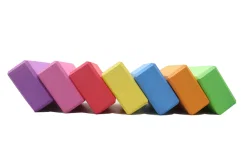Here are some key aspects of yoga blocks
2024-03-05
A yoga block is a supportive prop commonly used in yoga practice to help practitioners achieve proper alignment, balance, and support during various poses and exercises. Yoga blocks are typically made of foam, cork, or other lightweight, durable materials. They come in different shapes, sizes, and colors. Here are some key aspects of yoga blocks:
1. Size and Dimensions:
- Yoga blocks are typically rectangular and come in different sizes. The most common dimensions are 3 inches by 6 inches by 9 inches. Some blocks may be larger or smaller, catering to individual preferences and needs.
2. Material:
- Foam and cork are the most common materials for yoga blocks. Foam blocks are lightweight, soft, and affordable, making them suitable for beginners. Cork blocks are more durable, environmentally friendly, and provide a firmer surface.
3. Usage:
- Yoga blocks are versatile and can be used in various ways:
- Support: Placed under hands, feet, or hips to provide support during poses where flexibility or strength may be limited.
- Balance: Used to help with balance and stability during standing or seated poses.
- Modification: Assist in modifying poses for individuals with limited flexibility or injuries.
- Extension: Extend the reach and range of motion in certain stretches and poses.
4. Level of Support:
- Yoga blocks are available in different densities, providing varying levels of support. Some blocks are softer and more compressible, while others are firmer for greater stability.
5. Color Variations:
- While color doesn't affect the function, yoga blocks come in a variety of colors. The color may be a matter of personal preference or match the overall aesthetic of a yoga practice space.
6. Eco-Friendly Options:
- For those concerned about environmental impact, there are eco-friendly yoga blocks made from sustainable materials such as recycled foam or bamboo.
7. Easy to Clean:
- Yoga blocks are generally easy to clean. Foam blocks can be wiped down with a damp cloth, while cork blocks may require more gentle cleaning to preserve their natural properties.
8. Portability:
- Yoga blocks are lightweight and easy to carry, making them a convenient accessory for both studio and home practice.
9. Cost:
- Yoga blocks are affordable yoga accessories, making them accessible for practitioners of all levels.
10. Pairing with Other Props:
- Yoga blocks are often used in conjunction with other yoga props like straps or blankets to enhance the practice and accommodate different needs.
Whether you are a beginner or an experienced yogi, incorporating yoga blocks into your practice can provide valuable support, enhance alignment, and deepen your yoga experience. They are especially beneficial for individuals working on improving flexibility, strength, and balance.



